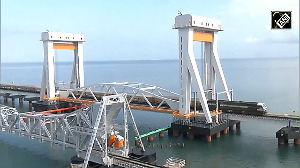Ever wondered what interest rates are actually levied on the 'zero interest finance' schemes often used to purchase consumer durable such as televisions or refrigerators?
Banks and finance companies running the so-called 'zero per cent finance schemes' are actually charging interest ranging from 13 per cent to 16 per cent -- two to three percentage points above prime lending rates.
The Reserve Bank of India had earlier specifically mentioned that no bank and financial company could provide personal loans at rates lower than the prime lending rate. This restriction was recently lifted.
Banking sources say, "The modus operandi of these banks and financial companies are simple -- a heavy processing fee is part of the scheme and this is in reality a portion of the interest. The processing fees for consumer durable are lump sum amounts that a consumer has to pay upfront. The buyer also loses out on the 'cash discount' that is always offered on a consumer durable and this benefit accounts for the balance interest on the zero interest scheme."
In most cases the price of the consumer durable is fixed with the interest component added to the price of the product, which is stripped off if a consumer pays upfront as a 'cash discount.'
A consumer durable manufacturer allows certain margin on a product to the dealer and retailer, a portion of which is often passed onto the consumer.
With these so called 'zero interest' schemes dealers rarely pass on these margin to consumers now. This provides the final additional return on the zero interest plan.
The calculation presented by the financier to the consumer has no mention of these invisible payments built into the scheme in lieu of actual interest.
Under the scheme, the price of the product will be divided by 12 -- thus arriving at the equated monthly instalment to be paid.
A consumer has to pay up-front four instalments in advance, while the rest is paid over eight months.
The interest charge becomes apparent when a consumer wants to pay more as advance payment. Finance companies then either decline to finance the product or fall back to the actual rate of interest which is around 13 per cent per annum or more.
When it comes to vehicle financing the ball game is a little different.
Different manufacturers along with banks have declared schemes that claim to charge zero rates in the first year and around 4 per cent for flat rate of interest or 10.5 per cent for floating interest rates.
A zero rate of interest in the first year is not actually zero -- it comes to 12 to 13 per cent per annum or a little less.
The interest components here are the discount that the dealer gets from manufacturers along with the processing as well as interest costs that the consumer needs to pay upfront the very first year.
These schemes generally charge around 1 to 1.5 per cent of the price of the vehicle, and not on the loan amount as processing fees along with another 1 to 1.5 per cent as administrative charges on the price of the car.
These two accounts for a portion of the interest cost. The dealers' subvention which is not passed onto the consumer also accounts for another portion of the interest cost.
Bankers dealing in vehicle financing said that when banks design a product -- the interest rate is considered a direct factor of the risk involved with advancing the amount and the type of asset being.
Every bank works in the risk factor along with the interest rate in the products hence the rate return on a the loan component that the bank gets in return is predetermined.
Vehicles with high rates of depreciation will obviously demand a rate of interest which is higher than the interest rates for home loans which has a low element of depreciation and a mortgage of more secured nature compared to vehicles.
So if home loans are ruling at around 9 per cent on an average, car finance rates will have to be logically higher.







 © 2025
© 2025